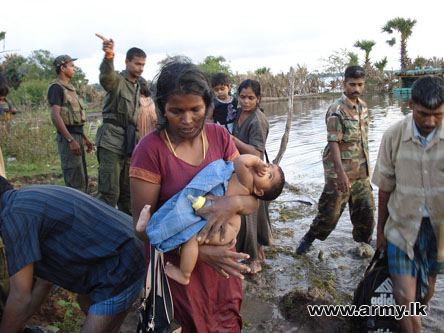The warning comes as clashes between government forces and the Liberation Tigers of Tamil Eelam (LTTE), who have been fighting for an independent homeland since 1983, intensify.
“The situation is desperate. The population trapped inside the combat zone has been displaced so many times. It is completely dependent on outside supplies [of food and medicine] for survival,” Sophie Romanens, ICRC communications coordinator in Sri Lanka, told IRIN.
In a statement on 17 March, ICRC confirmed that tens of thousands of people confined to a rapidly shrinking area had headed for the coast to escape the fighting, in search of safety, food and medical care.
“The area is affected by shelling every day, and the cramped conditions and lack of water and proper sanitation are putting people at risk of epidemics,” the ICRC, the only international agency with a staff presence inside the combat zone, said.
Heavy rains are compounding the problem. “You can just imagine the situation, with thousands of people under tarpaulins or tents and water everywhere, and poor sanitation facilities,” Romanens said.
Fighting between Sri Lankan government forces and the LTTE has forced tens of thousands to flee in and around the northern Mullaithivu District since late December.
Most have moved into a 12km no-fire zone declared by the government at the eastern edge of the combat zone on 21 February.
|
According to the authorities, more than 42,000 have fled to government-controlled areas and are now being housed at 22 relief sites in the northern districts of Mannar, Vavuniya and Jaffna.
Over 1,500 escaped into government areas in the last week.
Vital sea supplies
Since early February the ICRC has been facilitating the sea-borne evacuation of sick and wounded civilians and the transport of supplies to the combat zone by ship after the suspension of overland convoys due to deteriorating security.
The Sri Lankan government said that despite allegations that the bulk of the supplies sent to combat zones were being siphoned off by the LTTE, deliveries would continue.
“We can send medicine, we can send food stuffs [to the combat zone], but the LTTE takes charge of all of them,” Nimal Siripala de Silva, the Sri Lankan Health Minister, told a press conference at the Foreign Ministry on 17 March. “What they give [to the civilians] is a small portion [but] because of that we are not stopping the inflow of medicine and food items.”
The ICRC said the naval supply route was now a vital lifeline into the combat zone.
“With patients continuing to arrive at the improvised medical facility in Putumattalan [a coastal village inside the safe zone], it is essential that evacuations take place regularly and without interference,” Morven Murchison, ICRC medical coordinator in Sri Lanka, said. "It is encouraging to see food and medicines going into the conflict area, but they must be delivered regularly if they are to have an impact."
ap/ds/mw
This article was produced by IRIN News while it was part of the United Nations Office for the Coordination of Humanitarian Affairs. Please send queries on copyright or liability to the UN. For more information: https://shop.un.org/rights-permissions






